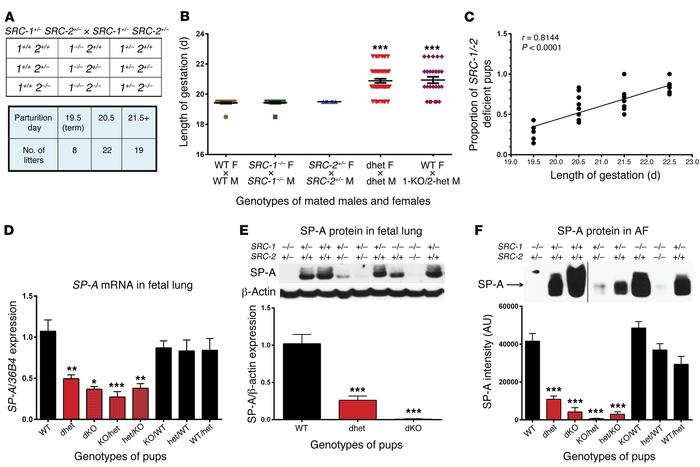Citation Information: J Clin Invest. 2015;125(7):2808-2824. https://doi.org/10.1172/JCI78544.
Steroid receptor coactivators 1 and 2 mediate fetal-to-maternal signaling that initiates parturition
Abstract
The precise mechanisms that lead to parturition are incompletely defined. Surfactant protein-A (SP-A), which is secreted by fetal lungs into amniotic fluid (AF) near term, likely provides a signal for parturition; however, SP-A–deficient mice have only a relatively modest delay (~12 hours) in parturition, suggesting additional factors. Here, we evaluated the contribution of steroid receptor coactivators 1 and 2 (SRC-1 and SRC-2), which upregulate SP-A transcription, to the parturition process. As mice lacking both SRC-1 and SRC-2 die at birth due to respiratory distress, we crossed double-heterozygous males and females. Parturition was severely delayed (~38 hours) in heterozygous dams harboring SRC-1/-2–deficient embryos. These mothers exhibited decreased myometrial NF-κB activation, PGF2α, and expression of contraction-associated genes; impaired luteolysis; and elevated circulating progesterone. These manifestations also occurred in WT females bearing SRC-1/-2 double-deficient embryos, indicating that a fetal-specific defect delayed labor. SP-A, as well as the enzyme lysophosphatidylcholine acyltransferase-1 (LPCAT1), required for synthesis of surfactant dipalmitoylphosphatidylcholine, and the proinflammatory glycerophospholipid platelet-activating factor (PAF) were markedly reduced in SRC-1/-2–deficient fetal lungs near term. Injection of PAF or SP-A into AF at 17.5 days post coitum enhanced uterine NF-κB activation and contractile gene expression, promoted luteolysis, and rescued delayed parturition in SRC-1/-2–deficient embryo-bearing dams. These findings reveal that fetal lungs produce signals to initiate labor when mature and that SRC-1/-2–dependent production of SP-A and PAF is crucial for this process.
Authors
Lu Gao, Elizabeth H. Rabbitt, Jennifer C. Condon, Nora E. Renthal, John M. Johnston, Matthew A. Mitsche, Pierre Chambon, Jianming Xu, Bert W. O’Malley, Carole R. Mendelson
Figure 1
Delayed parturition in



Copyright © 2025 American Society for Clinical Investigation
ISSN: 0021-9738 (print), 1558-8238 (online)

